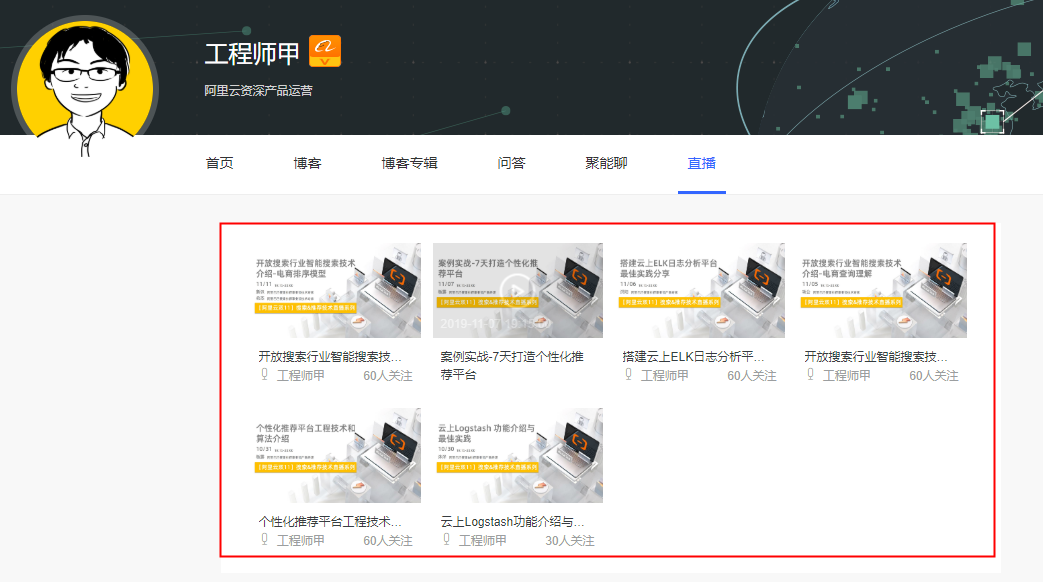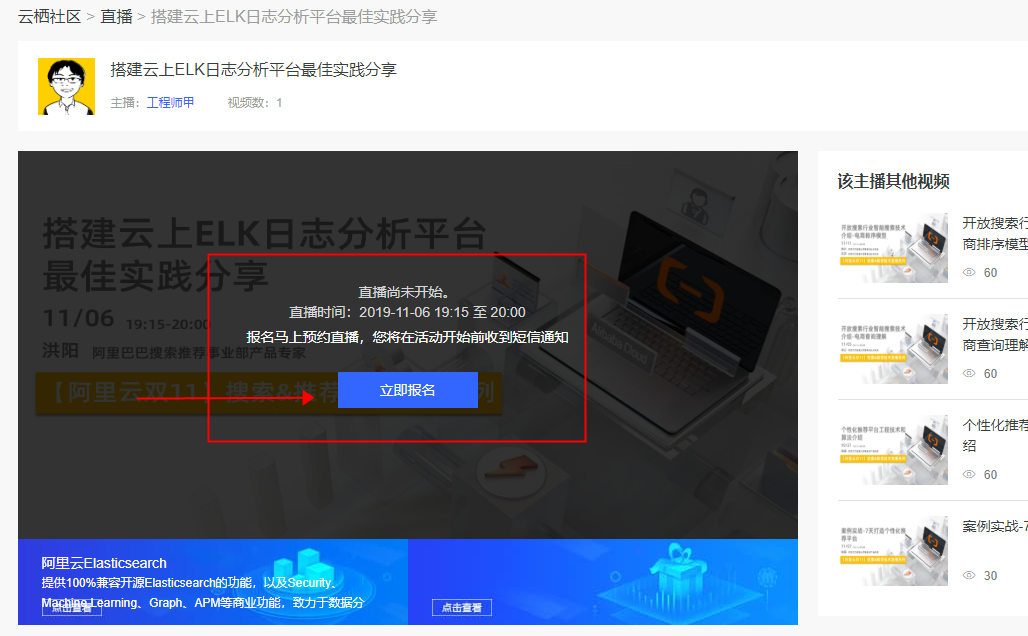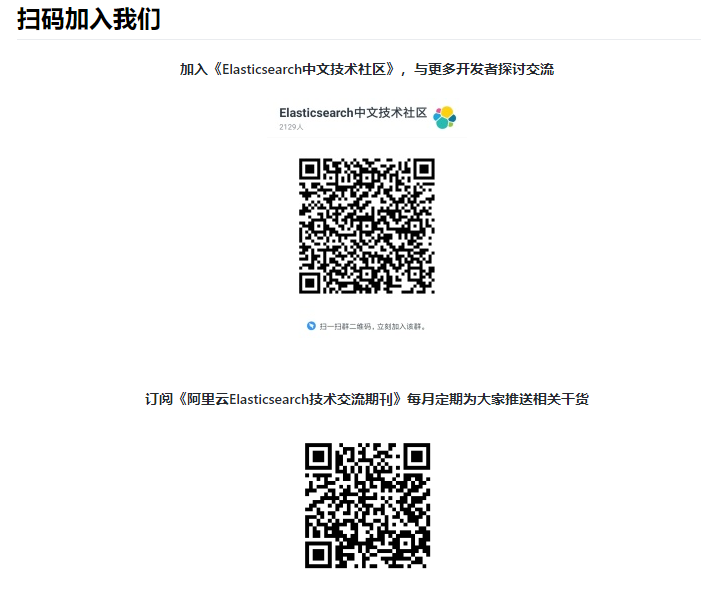社区日报 第772期 (2019-11-04)
http://t.cn/AiBIEfga
2、避免OOM的利器:ElasticSeach 7.x 实际内存断路器
https://www.elastic.co/cn/blog ... eaker
3、了解es 7.x使用的最新jdk12特性,避免运维踩坑
http://t.cn/ExjQUV7
编辑:cyberdak
归档:https://ela.st/cn-daily-all
订阅:https://ela.st/cn-daily-sub
沙龙:https://ela.st/cn-meetup
http://t.cn/AiBIEfga
2、避免OOM的利器:ElasticSeach 7.x 实际内存断路器
https://www.elastic.co/cn/blog ... eaker
3、了解es 7.x使用的最新jdk12特性,避免运维踩坑
http://t.cn/ExjQUV7
编辑:cyberdak
归档:https://ela.st/cn-daily-all
订阅:https://ela.st/cn-daily-sub
沙龙:https://ela.st/cn-meetup 收起阅读 »
社区日报 第771期 (2019-11-03)
http://t.cn/AiByJuok
2.(自备梯子)Docker部署Elasticsearch。
http://t.cn/AiByxZxu
3.(自备梯子)什么时候需要区块链?
http://t.cn/EX7OY1A
编辑:至尊宝
归档:https://ela.st/cn-daily-all
订阅:https://ela.st/cn-daily-sub
沙龙:https://ela.st/cn-meetup
http://t.cn/AiByJuok
2.(自备梯子)Docker部署Elasticsearch。
http://t.cn/AiByxZxu
3.(自备梯子)什么时候需要区块链?
http://t.cn/EX7OY1A
编辑:至尊宝
归档:https://ela.st/cn-daily-all
订阅:https://ela.st/cn-daily-sub
沙龙:https://ela.st/cn-meetup 收起阅读 »
深入理解Elasticsearch写入过程
Elasticsearch 是当前主流的搜索引擎,其具有扩展性好,查询速度快,查询结果近实时等优点,本文将对Elasticsearch的写操作进行分析。
1. lucene的写操作及其问题
Elasticsearch底层使用Lucene来实现doc的读写操作,Lucene通过
public long addDocument(...);
public long deleteDocuments(...);
public long updateDocument(...);三个方法来实现文档的写入,更新和删除操作。但是存在如下问题
- 没有并发设计
lucene只是一个搜索引擎库,并没有涉及到分布式相关的设计,因此要想使用Lucene来处理海量数据,并利用分布式的能力,就必须在其之上进行分布式的相关设计。 - 非实时
将文件写入lucence后并不能立即被检索,需要等待lucene生成一个完整的segment才能被检索 - 数据存储不可靠
写入lucene的数据不会立即被持久化到磁盘,如果服务器宕机,那存储在内存中的数据将会丢失 - 不支持部分更新
lucene中提供的updateDocuments仅支持对文档的全量更新,对部分更新不支持
2. Elasticsearch的写入方案
针对Lucene的问题,ES做了如下设计
2.1 分布式设计:
为了支持对海量数据的存储和查询,Elasticsearch引入分片的概念,一个索引被分成多个分片,每个分片可以有一个主分片和多个副本分片,每个分片副本都是一个具有完整功能的lucene实例。分片可以分配在不同的服务器上,同一个分片的不同副本不能分配在相同的服务器上。
在进行写操作时,ES会根据传入的_routing参数(或mapping中设置的_routing, 如果参数和设置中都没有则默认使用_id), 按照公式shard_num = hash(\routing) % num_primary_shards,计算出文档要分配到的分片,在从集群元数据中找出对应主分片的位置,将请求路由到该分片进行文档写操作。

2.2 近实时性-refresh操作
当一个文档写入Lucene后是不能被立即查询到的,Elasticsearch提供了一个refresh操作,会定时地调用lucene的reopen(新版本为openIfChanged)为内存中新写入的数据生成一个新的segment,此时被处理的文档均可以被检索到。refresh操作的时间间隔由refresh_interval参数控制,默认为1s, 当然还可以在写入请求中带上refresh表示写入后立即refresh,另外还可以调用refresh API显式refresh。
2.3 数据存储可靠性
- 引入translog
当一个文档写入Lucence后是存储在内存中的,即使执行了refresh操作仍然是在文件系统缓存中,如果此时服务器宕机,那么这部分数据将会丢失。为此ES增加了translog, 当进行文档写操作时会先将文档写入Lucene,然后写入一份到translog,写入translog是落盘的(如果对可靠性要求不是很高,也可以设置异步落盘,可以提高性能,由配置index.translog.durability和index.translog.sync_interval控制),这样就可以防止服务器宕机后数据的丢失。由于translog是追加写入,因此性能比较好。与传统的分布式系统不同,这里是先写入Lucene再写入translog,原因是写入Lucene可能会失败,为了减少写入失败回滚的复杂度,因此先写入Lucene. - flush操作
另外每30分钟或当translog达到一定大小(由index.translog.flush_threshold_size控制,默认512mb), ES会触发一次flush操作,此时ES会先执行refresh操作将buffer中的数据生成segment,然后调用lucene的commit方法将所有内存中的segment fsync到磁盘。此时lucene中的数据就完成了持久化,会清空translog中的数据(6.x版本为了实现sequenceIDs,不删除translog)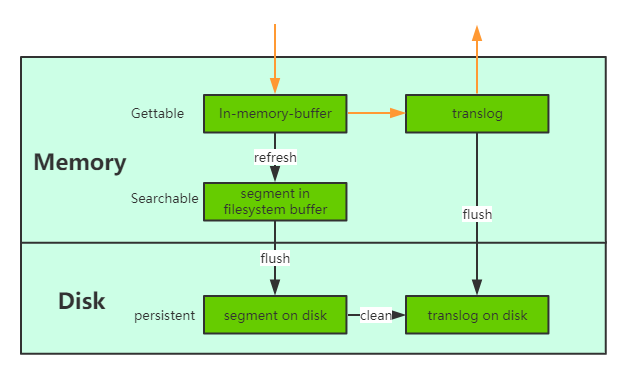
- merge操作
由于refresh默认间隔为1s中,因此会产生大量的小segment,为此ES会运行一个任务检测当前磁盘中的segment,对符合条件的segment进行合并操作,减少lucene中的segment个数,提高查询速度,降低负载。不仅如此,merge过程也是文档删除和更新操作后,旧的doc真正被删除的时候。用户还可以手动调用_forcemerge API来主动触发merge,以减少集群的segment个数和清理已删除或更新的文档。 - 多副本机制
另外ES有多副本机制,一个分片的主副分片不能分片在同一个节点上,进一步保证数据的可靠性。2.4 部分更新
lucene支持对文档的整体更新,ES为了支持局部更新,在Lucene的Store索引中存储了一个_source字段,该字段的key值是文档ID, 内容是文档的原文。当进行更新操作时先从_source中获取原文,与更新部分合并后,再调用lucene API进行全量更新, 对于写入了ES但是还没有refresh的文档,可以从translog中获取。另外为了防止读取文档过程后执行更新前有其他线程修改了文档,ES增加了版本机制,当执行更新操作时发现当前文档的版本与预期不符,则会重新获取文档再更新。
3. ES的写入流程
ES的任意节点都可以作为协调节点(coordinating node)接受请求,当协调节点接受到请求后进行一系列处理,然后通过_routing字段找到对应的primary shard,并将请求转发给primary shard, primary shard完成写入后,将写入并发发送给各replica, raplica执行写入操作后返回给primary shard, primary shard再将请求返回给协调节点。大致流程如下图:
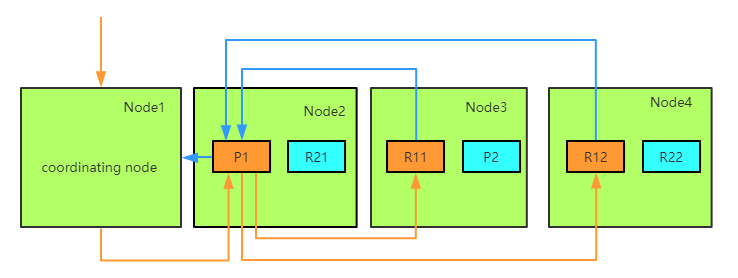
3.1 coordinating节点
ES中接收并转发请求的节点称为coordinating节点,ES中所有节点都可以接受并转发请求。当一个节点接受到写请求或更新请求后,会执行如下操作:
- ingest pipeline
查看该请求是否符合某个ingest pipeline的pattern, 如果符合则执行pipeline中的逻辑,一般是对文档进行各种预处理,如格式调整,增加字段等。如果当前节点没有ingest角色,则需要将请求转发给有ingest角色的节点执行。 - 自动创建索引
判断索引是否存在,如果开启了自动创建则自动创建,否则报错 - 设置routing
获取请求URL或mapping中的_routing,如果没有则使用_id, 如果没有指定_id则ES会自动生成一个全局唯一ID。该_routing字段用于决定文档分配在索引的哪个shard上。 - 构建BulkShardRequest
由于Bulk Request中包含多种(Index/Update/Delete)请求,这些请求分别需要到不同的shard上执行,因此协调节点,会将请求按照shard分开,同一个shard上的请求聚合到一起,构建BulkShardRequest - 将请求发送给primary shard
因为当前执行的是写操作,因此只能在primary上完成,所以需要把请求路由到primary shard所在节点 - 等待primary shard返回
3.2 primary shard
Primary请求的入口是PrimaryOperationTransportHandler的MessageReceived, 当接收到请求时,执行的逻辑如下
- 判断操作类型
遍历bulk请求中的各子请求,根据不同的操作类型跳转到不同的处理逻辑 - 将update操作转换为Index和Delete操作
获取文档的当前内容,与update内容合并生成新文档,然后将update请求转换成index请求,此处文档设置一个version v1 - Parse Doc
解析文档的各字段,并添加如_uid等ES相关的一些系统字段 - 更新mapping
对于新增字段会根据dynamic mapping或dynamic template生成对应的mapping,如果mapping中有dynamic mapping相关设置则按设置处理,如忽略或抛出异常 - 获取sequence Id和Version
从SequcenceNumberService获取一个sequenceID和Version。SequcenID用于初始化LocalCheckPoint, verion是根据当前Versoin+1用于防止并发写导致数据不一致。 - 写入lucene
这一步开始会对文档uid加锁,然后判断uid对应的version v2和之前update转换时的versoin v1是否一致,不一致则返回第二步重新执行。 如果version一致,如果同id的doc已经存在,则调用lucene的updateDocument接口,如果是新文档则调用lucene的addDoucument. 这里有个问题,如何保证Delete-Then-Add的原子性,ES是通过在Delete之前会加上已refresh锁,禁止被refresh,只有等待Add完成后释放了Refresh Lock, 这样就保证了这个操作的原子性。 - 写入translog
写入Lucene的Segment后,会以key value的形式写Translog, Key是Id, Value是Doc的内容。当查询的时候,如果请求的是GetDocById则可以直接根据_id从translog中获取。满足nosql场景的实时性。 - 重构bulk request
因为primary shard已经将update操作转换为index操作或delete操作,因此要对之前的bulkrequest进行调整,只包含index或delete操作,不需要再进行update的处理操作。 - flush translog
默认情况下,translog要在此处落盘完成,如果对可靠性要求不高,可以设置translog异步,那么translog的fsync将会异步执行,但是落盘前的数据有丢失风险。 - 发送请求给replicas
将构造好的bulkrequest并发发送给各replicas,等待replica返回,这里需要等待所有的replicas返回,响应请求给协调节点。如果某个shard执行失败,则primary会给master发请求remove该shard。这里会同时把sequenceID, primaryTerm, GlobalCheckPoint等传递给replica。 - 等待replica响应
当所有的replica返回请求时,更细primary shard的LocalCheckPoint。
3.3 replica shard
Replica 请求的入口是在ReplicaOperationTransportHandler的messageReceived,当replica shard接收到请求时执行如下流程:
- 判断操作类型
replica收到的写如请求只会有add和delete,因update在primary shard上已经转换为add或delete了。根据不同的操作类型执行对应的操作 - Parse Doc
- 更新mapping
- 获取sequenceId和Version 直接使用primary shard发送过来的请求中的内容即可
- 写如lucene
- write Translog
- Flush translog
4 总结与分析
Elasticsearch建立在Lucene基础之上,底层采用lucene来实现文件的读写操作,实现了文档的存储和高效查询。然后lucene作为一个搜索库在应对海量数据的存储上仍有一些不足之处。
Elasticsearch通过引入分片概念,成功地将lucene部署到分布式系统中,增强了系统的可靠性和扩展性。
Elasticsearch通过定期refresh lucene in-momory-buffer中的数据,使得ES具有了近实时的写入和查询能力。
Elasticsearch通过引入translog,多副本,以及定期执行flush,merge等操作保证了数据可靠性和较高的存储性能。
Elasticsearch通过存储_source字段结合verison字段实现了文档的局部更新,使得ES的使用方式更加灵活多样。
Elasticsearch基于lucene,又不简单地只是lucene,它完美地将lucene与分布式系统结合,既利用了lucene的检索能力,又具有了分布式系统的众多优点。
本文参考
欢迎关注公众号Elastic慕容,和我一起进入Elastic的奇妙世界吧

Elasticsearch 是当前主流的搜索引擎,其具有扩展性好,查询速度快,查询结果近实时等优点,本文将对Elasticsearch的写操作进行分析。
1. lucene的写操作及其问题
Elasticsearch底层使用Lucene来实现doc的读写操作,Lucene通过
public long addDocument(...);
public long deleteDocuments(...);
public long updateDocument(...);三个方法来实现文档的写入,更新和删除操作。但是存在如下问题
- 没有并发设计
lucene只是一个搜索引擎库,并没有涉及到分布式相关的设计,因此要想使用Lucene来处理海量数据,并利用分布式的能力,就必须在其之上进行分布式的相关设计。 - 非实时
将文件写入lucence后并不能立即被检索,需要等待lucene生成一个完整的segment才能被检索 - 数据存储不可靠
写入lucene的数据不会立即被持久化到磁盘,如果服务器宕机,那存储在内存中的数据将会丢失 - 不支持部分更新
lucene中提供的updateDocuments仅支持对文档的全量更新,对部分更新不支持
2. Elasticsearch的写入方案
针对Lucene的问题,ES做了如下设计
2.1 分布式设计:
为了支持对海量数据的存储和查询,Elasticsearch引入分片的概念,一个索引被分成多个分片,每个分片可以有一个主分片和多个副本分片,每个分片副本都是一个具有完整功能的lucene实例。分片可以分配在不同的服务器上,同一个分片的不同副本不能分配在相同的服务器上。
在进行写操作时,ES会根据传入的_routing参数(或mapping中设置的_routing, 如果参数和设置中都没有则默认使用_id), 按照公式shard_num = hash(\routing) % num_primary_shards,计算出文档要分配到的分片,在从集群元数据中找出对应主分片的位置,将请求路由到该分片进行文档写操作。

2.2 近实时性-refresh操作
当一个文档写入Lucene后是不能被立即查询到的,Elasticsearch提供了一个refresh操作,会定时地调用lucene的reopen(新版本为openIfChanged)为内存中新写入的数据生成一个新的segment,此时被处理的文档均可以被检索到。refresh操作的时间间隔由refresh_interval参数控制,默认为1s, 当然还可以在写入请求中带上refresh表示写入后立即refresh,另外还可以调用refresh API显式refresh。
2.3 数据存储可靠性
- 引入translog
当一个文档写入Lucence后是存储在内存中的,即使执行了refresh操作仍然是在文件系统缓存中,如果此时服务器宕机,那么这部分数据将会丢失。为此ES增加了translog, 当进行文档写操作时会先将文档写入Lucene,然后写入一份到translog,写入translog是落盘的(如果对可靠性要求不是很高,也可以设置异步落盘,可以提高性能,由配置index.translog.durability和index.translog.sync_interval控制),这样就可以防止服务器宕机后数据的丢失。由于translog是追加写入,因此性能比较好。与传统的分布式系统不同,这里是先写入Lucene再写入translog,原因是写入Lucene可能会失败,为了减少写入失败回滚的复杂度,因此先写入Lucene. - flush操作
另外每30分钟或当translog达到一定大小(由index.translog.flush_threshold_size控制,默认512mb), ES会触发一次flush操作,此时ES会先执行refresh操作将buffer中的数据生成segment,然后调用lucene的commit方法将所有内存中的segment fsync到磁盘。此时lucene中的数据就完成了持久化,会清空translog中的数据(6.x版本为了实现sequenceIDs,不删除translog)
- merge操作
由于refresh默认间隔为1s中,因此会产生大量的小segment,为此ES会运行一个任务检测当前磁盘中的segment,对符合条件的segment进行合并操作,减少lucene中的segment个数,提高查询速度,降低负载。不仅如此,merge过程也是文档删除和更新操作后,旧的doc真正被删除的时候。用户还可以手动调用_forcemerge API来主动触发merge,以减少集群的segment个数和清理已删除或更新的文档。 - 多副本机制
另外ES有多副本机制,一个分片的主副分片不能分片在同一个节点上,进一步保证数据的可靠性。2.4 部分更新
lucene支持对文档的整体更新,ES为了支持局部更新,在Lucene的Store索引中存储了一个_source字段,该字段的key值是文档ID, 内容是文档的原文。当进行更新操作时先从_source中获取原文,与更新部分合并后,再调用lucene API进行全量更新, 对于写入了ES但是还没有refresh的文档,可以从translog中获取。另外为了防止读取文档过程后执行更新前有其他线程修改了文档,ES增加了版本机制,当执行更新操作时发现当前文档的版本与预期不符,则会重新获取文档再更新。
3. ES的写入流程
ES的任意节点都可以作为协调节点(coordinating node)接受请求,当协调节点接受到请求后进行一系列处理,然后通过_routing字段找到对应的primary shard,并将请求转发给primary shard, primary shard完成写入后,将写入并发发送给各replica, raplica执行写入操作后返回给primary shard, primary shard再将请求返回给协调节点。大致流程如下图:

3.1 coordinating节点
ES中接收并转发请求的节点称为coordinating节点,ES中所有节点都可以接受并转发请求。当一个节点接受到写请求或更新请求后,会执行如下操作:
- ingest pipeline
查看该请求是否符合某个ingest pipeline的pattern, 如果符合则执行pipeline中的逻辑,一般是对文档进行各种预处理,如格式调整,增加字段等。如果当前节点没有ingest角色,则需要将请求转发给有ingest角色的节点执行。 - 自动创建索引
判断索引是否存在,如果开启了自动创建则自动创建,否则报错 - 设置routing
获取请求URL或mapping中的_routing,如果没有则使用_id, 如果没有指定_id则ES会自动生成一个全局唯一ID。该_routing字段用于决定文档分配在索引的哪个shard上。 - 构建BulkShardRequest
由于Bulk Request中包含多种(Index/Update/Delete)请求,这些请求分别需要到不同的shard上执行,因此协调节点,会将请求按照shard分开,同一个shard上的请求聚合到一起,构建BulkShardRequest - 将请求发送给primary shard
因为当前执行的是写操作,因此只能在primary上完成,所以需要把请求路由到primary shard所在节点 - 等待primary shard返回
3.2 primary shard
Primary请求的入口是PrimaryOperationTransportHandler的MessageReceived, 当接收到请求时,执行的逻辑如下
- 判断操作类型
遍历bulk请求中的各子请求,根据不同的操作类型跳转到不同的处理逻辑 - 将update操作转换为Index和Delete操作
获取文档的当前内容,与update内容合并生成新文档,然后将update请求转换成index请求,此处文档设置一个version v1 - Parse Doc
解析文档的各字段,并添加如_uid等ES相关的一些系统字段 - 更新mapping
对于新增字段会根据dynamic mapping或dynamic template生成对应的mapping,如果mapping中有dynamic mapping相关设置则按设置处理,如忽略或抛出异常 - 获取sequence Id和Version
从SequcenceNumberService获取一个sequenceID和Version。SequcenID用于初始化LocalCheckPoint, verion是根据当前Versoin+1用于防止并发写导致数据不一致。 - 写入lucene
这一步开始会对文档uid加锁,然后判断uid对应的version v2和之前update转换时的versoin v1是否一致,不一致则返回第二步重新执行。 如果version一致,如果同id的doc已经存在,则调用lucene的updateDocument接口,如果是新文档则调用lucene的addDoucument. 这里有个问题,如何保证Delete-Then-Add的原子性,ES是通过在Delete之前会加上已refresh锁,禁止被refresh,只有等待Add完成后释放了Refresh Lock, 这样就保证了这个操作的原子性。 - 写入translog
写入Lucene的Segment后,会以key value的形式写Translog, Key是Id, Value是Doc的内容。当查询的时候,如果请求的是GetDocById则可以直接根据_id从translog中获取。满足nosql场景的实时性。 - 重构bulk request
因为primary shard已经将update操作转换为index操作或delete操作,因此要对之前的bulkrequest进行调整,只包含index或delete操作,不需要再进行update的处理操作。 - flush translog
默认情况下,translog要在此处落盘完成,如果对可靠性要求不高,可以设置translog异步,那么translog的fsync将会异步执行,但是落盘前的数据有丢失风险。 - 发送请求给replicas
将构造好的bulkrequest并发发送给各replicas,等待replica返回,这里需要等待所有的replicas返回,响应请求给协调节点。如果某个shard执行失败,则primary会给master发请求remove该shard。这里会同时把sequenceID, primaryTerm, GlobalCheckPoint等传递给replica。 - 等待replica响应
当所有的replica返回请求时,更细primary shard的LocalCheckPoint。
3.3 replica shard
Replica 请求的入口是在ReplicaOperationTransportHandler的messageReceived,当replica shard接收到请求时执行如下流程:
- 判断操作类型
replica收到的写如请求只会有add和delete,因update在primary shard上已经转换为add或delete了。根据不同的操作类型执行对应的操作 - Parse Doc
- 更新mapping
- 获取sequenceId和Version 直接使用primary shard发送过来的请求中的内容即可
- 写如lucene
- write Translog
- Flush translog
4 总结与分析
Elasticsearch建立在Lucene基础之上,底层采用lucene来实现文件的读写操作,实现了文档的存储和高效查询。然后lucene作为一个搜索库在应对海量数据的存储上仍有一些不足之处。
Elasticsearch通过引入分片概念,成功地将lucene部署到分布式系统中,增强了系统的可靠性和扩展性。
Elasticsearch通过定期refresh lucene in-momory-buffer中的数据,使得ES具有了近实时的写入和查询能力。
Elasticsearch通过引入translog,多副本,以及定期执行flush,merge等操作保证了数据可靠性和较高的存储性能。
Elasticsearch通过存储_source字段结合verison字段实现了文档的局部更新,使得ES的使用方式更加灵活多样。
Elasticsearch基于lucene,又不简单地只是lucene,它完美地将lucene与分布式系统结合,既利用了lucene的检索能力,又具有了分布式系统的众多优点。
本文参考
欢迎关注公众号Elastic慕容,和我一起进入Elastic的奇妙世界吧

社区日报 第770期 (2019-11-02)
社区日报 第769期 (2019-11-01)
1、将Elasticsearch碎片减少90%以提高性能(梯子)
http://t.cn/Ai1s3LKe
2、为 Laravel Scout 开发的 Elasticsearch 驱动
http://t.cn/Ai1s3taf
3、每秒在Elasticsearch中存储5000万个事件:我们是如何做到的?
http://t.cn/Ai1s3aVT
编辑:铭毅天下
归档:https://ela.st/cn-daily-all
订阅:https://ela.st/cn-daily-sub
沙龙:https://ela.st/cn-meetup
1、将Elasticsearch碎片减少90%以提高性能(梯子)
http://t.cn/Ai1s3LKe
2、为 Laravel Scout 开发的 Elasticsearch 驱动
http://t.cn/Ai1s3taf
3、每秒在Elasticsearch中存储5000万个事件:我们是如何做到的?
http://t.cn/Ai1s3aVT
编辑:铭毅天下
归档:https://ela.st/cn-daily-all
订阅:https://ela.st/cn-daily-sub
沙龙:https://ela.st/cn-meetup
收起阅读 »
Elastic认证工程师考试经验分享
笔者于2019年10月参加并通过了Elastic Certified Engineer Exam, 在准备考试的三四个月的时间内,对考试的要求,考试的准备,考试的流程等有一些了解,因此总结这篇文章,希望对后续参加考试的朋友有一定的帮助。
1. 考试简介
Elastic Certified Engineer Exam是Elastic官方推出的Elasticsearch使用能力认证考试,通过该考试表明考生具备了通过执行一些列操作构建完整Elasticsearch解决方案的能力,这些操作包括包括集群安装,配置,管理,数据索引,查询,分析等。 详细介绍可以参考[Elastic Certified Engineer]
2. 考察点
认证考试介绍页面中有对考察点有明确的说明,可以参考[Exam Objectives], 考察点主要是Elasticsearch的使用(不考察Elastic stack其他组件如kibana, beat, logstash等的使用),不考察Elasticsearch的实现原理,考察点主要包括:
- 集群的安装和配置:基本安装,配置,安全配置,角色和用户管理等
- 索引数据:索引和文档的各种操作
- 查询:各种查询场景
- 聚合:各种聚合查询,如指标聚合,分桶聚合,嵌套聚合,pipeline聚合等
- Mapping和Analzysis: 索引mapping和分词相关操作
- 集群管理: shard分配,集群健康诊断,备份与恢复,冷热分离,跨集群检索等。
上述只是简单列举,详情以Exam Objectives为准
3. 考试准备
建议参加[Official Elastic Training], 该培训对Elasticsearch的使用会有详细的讲解,并有配套的lab,学习完课程,并认真完成各lab基本就具备了通过考试的能力。
另外要对Elasticsearch官方文档的结构有较为清晰的了解,能快速的查找到相关文档,当然如果能熟练使用kibana文档跳转和文档的搜索功能也可以。
另外还有一些考试通过者的一些经验:
4. 考试报名
- 考试购买
- 注册Elastic Training网站
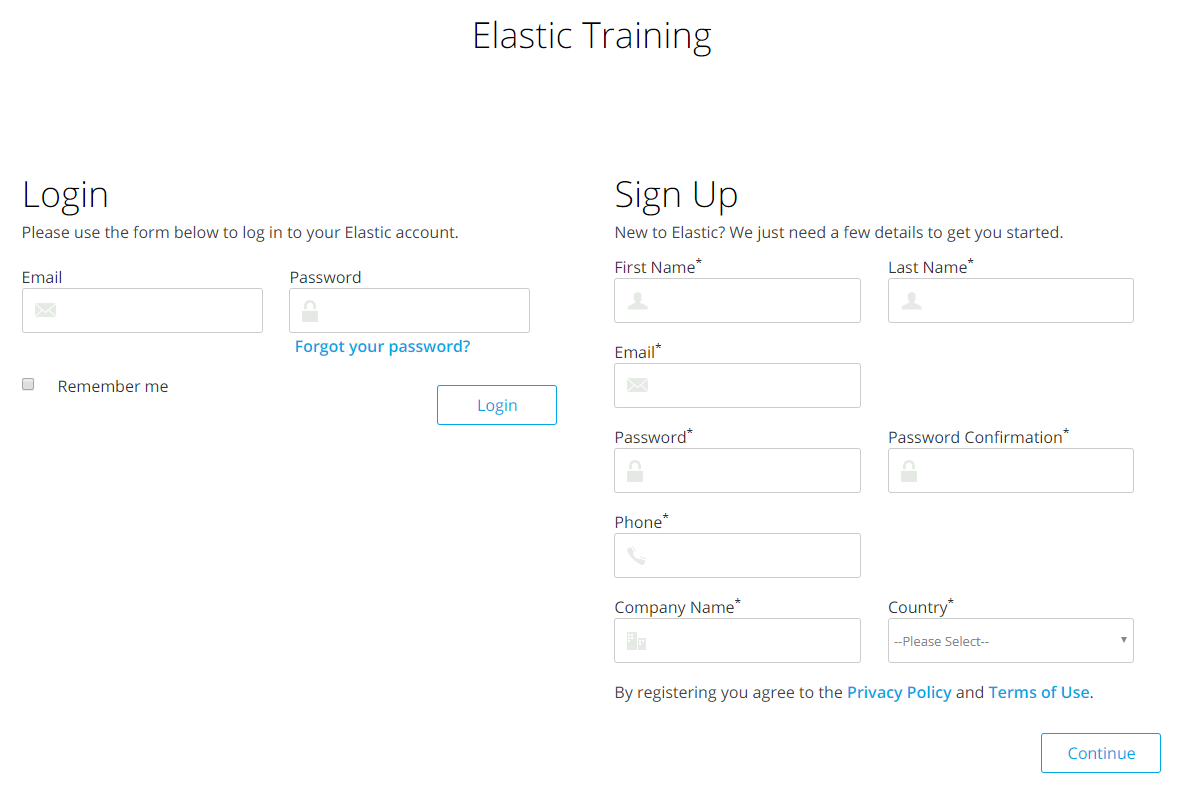
- 可以在认证考试页面进行考试报名
 按照指示步骤进行操作购买支付即可,考试费用是$400美元,可以使用visa或master信用卡支付
按照指示步骤进行操作购买支付即可,考试费用是$400美元,可以使用visa或master信用卡支付 - 支付完成在注册邮箱和Training网站账号页面的inbox中均会收到两封邮件,一封是订单信息,另一封是考试网站指引
 购买成功后考试有一年的有效期,可以在购买后的一年时间内的任意时间预约考试
购买成功后考试有一年的有效期,可以在购买后的一年时间内的任意时间预约考试
- 注册Elastic Training网站
- 考试预约
- 按照邮件指引注册examlocal 这是一个第三方考试网站,注意注册时使用和注册training网站相同的邮箱
- 在schedule an Exam页面搜索Elastic Certificate Exam

- 选择合适的考试时间,注意时区的选择

- 最后校验会有一个checklist,检测你当前机器是否符合要求
 这里要注意
这里要注意 - 要按照指引为浏览器安装插件
- 准备VPN,以保证考试时网络没有问题
- 考试时后台不能有任何进程,如果机器上有默认无法禁用的程序要注意
- 电脑要带摄像头和麦克风
5. 考试环境和流程
- 考试环境
考试环境是一个通过浏览器连接的远程centos系统,通过terminal连接考试的各集群服务器,通过系统内浏览器来查看官方文档和作答考卷。关于环境的讲解可以查看官方讲解视频,考试环境和讲解中完全一致 - 考试流程
考试开始前15分钟,考生通过考试网站指引进入考试系统,此时考官便可以通过摄像头和麦克风看到听到你,但是你是看不到听不到考官的,考官会通过一个聊天窗口与你打字沟通。
考官会要求你先出示你的证件,注意这里一定要使用护照等带有拼音的证件,毕竟外国人不认识中文,如果没有此类证件,想要使用身份证,需要提前写邮件给Elasitc申请。
接着考官会要求你抱着电脑环视周围,查看桌面上是否有任何物品,如果有物品如护照等,会被要求拿走放到其他地方。
接着考官会要求你打开你电脑的任务管理器,查看是否有除去浏览器的其他进程。
上述检查均通过后,便可以开始考试,考试时间是3个小时,考题也都是常规的一些集群使用相关的知识点,没有偏题怪题。考前看其他人的经验大概90分钟完成,我也基本在这个时间点完成。
考试过程中可以向考官申请中途休息和喝水,考官会暂停考试。建议做完第一遍后进行检查,可能会发现一些细节问题,如单节点集群考试创建的索引默认一副本会导致集群yellow等。
6. 考题回顾
正式进入考题前会有一个考题作答讲解和集群情况描述,我的环境是三个集群,第一个是三节点,另外两个都是一节点,每个集群都带有一个kibana。 我的考题共10道,我这里只对考题考点做简单描述:
- 冷热分离架构配置
- update_by_query + script按照要求更新索引
- 自定义分词插件,让king's和kings有相同的评分
- nested类型和nested query
- dynamic mapping
- multi-match, boost, most_fields
- date-histogram, sub-aggregation
- 开启security
- 集群备份snapshot
- match_phrase, hightlighting, sort
7. 考试结果
考试成绩会在三个工作日内公布,但实际一般一个工作日就会出结果。如果通过考试会收到一封考试通过的邮件,如下
 按照邮件指引便可以得到一个电子证书,如下图
按照邮件指引便可以得到一个电子证书,如下图
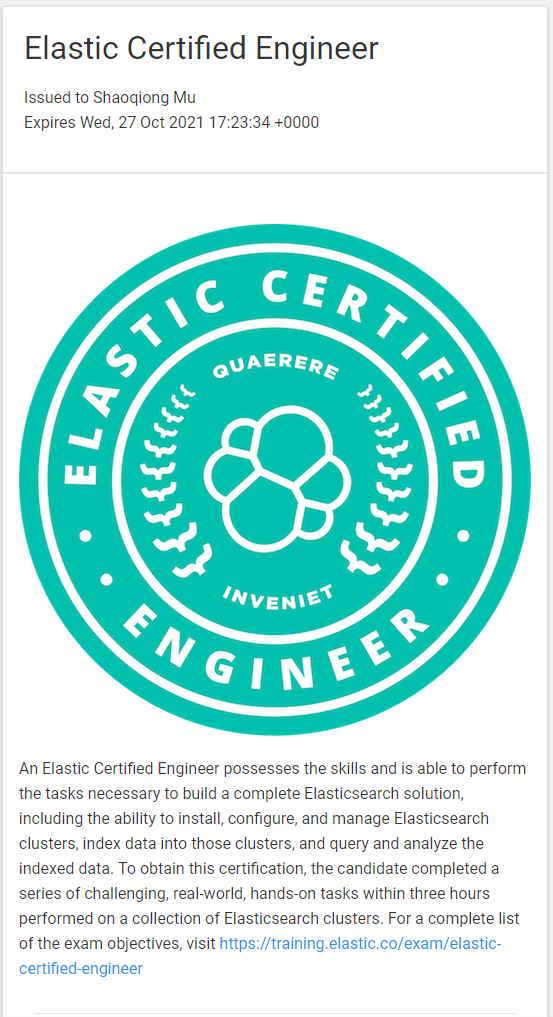
最后分享一下从大洋彼岸寄过来的纪念币
最后祝大家考试顺利(●'◡'●)
欢迎关注公众号Elastic慕容,和我一起进入Elastic的奇妙世界吧
笔者于2019年10月参加并通过了Elastic Certified Engineer Exam, 在准备考试的三四个月的时间内,对考试的要求,考试的准备,考试的流程等有一些了解,因此总结这篇文章,希望对后续参加考试的朋友有一定的帮助。
1. 考试简介
Elastic Certified Engineer Exam是Elastic官方推出的Elasticsearch使用能力认证考试,通过该考试表明考生具备了通过执行一些列操作构建完整Elasticsearch解决方案的能力,这些操作包括包括集群安装,配置,管理,数据索引,查询,分析等。 详细介绍可以参考[Elastic Certified Engineer]
2. 考察点
认证考试介绍页面中有对考察点有明确的说明,可以参考[Exam Objectives], 考察点主要是Elasticsearch的使用(不考察Elastic stack其他组件如kibana, beat, logstash等的使用),不考察Elasticsearch的实现原理,考察点主要包括:
- 集群的安装和配置:基本安装,配置,安全配置,角色和用户管理等
- 索引数据:索引和文档的各种操作
- 查询:各种查询场景
- 聚合:各种聚合查询,如指标聚合,分桶聚合,嵌套聚合,pipeline聚合等
- Mapping和Analzysis: 索引mapping和分词相关操作
- 集群管理: shard分配,集群健康诊断,备份与恢复,冷热分离,跨集群检索等。
上述只是简单列举,详情以Exam Objectives为准
3. 考试准备
建议参加[Official Elastic Training], 该培训对Elasticsearch的使用会有详细的讲解,并有配套的lab,学习完课程,并认真完成各lab基本就具备了通过考试的能力。
另外要对Elasticsearch官方文档的结构有较为清晰的了解,能快速的查找到相关文档,当然如果能熟练使用kibana文档跳转和文档的搜索功能也可以。
另外还有一些考试通过者的一些经验:
4. 考试报名
- 考试购买
- 注册Elastic Training网站

- 可以在认证考试页面进行考试报名
 按照指示步骤进行操作购买支付即可,考试费用是$400美元,可以使用visa或master信用卡支付
按照指示步骤进行操作购买支付即可,考试费用是$400美元,可以使用visa或master信用卡支付 - 支付完成在注册邮箱和Training网站账号页面的inbox中均会收到两封邮件,一封是订单信息,另一封是考试网站指引
 购买成功后考试有一年的有效期,可以在购买后的一年时间内的任意时间预约考试
购买成功后考试有一年的有效期,可以在购买后的一年时间内的任意时间预约考试
- 注册Elastic Training网站
- 考试预约
- 按照邮件指引注册examlocal 这是一个第三方考试网站,注意注册时使用和注册training网站相同的邮箱
- 在schedule an Exam页面搜索Elastic Certificate Exam

- 选择合适的考试时间,注意时区的选择

- 最后校验会有一个checklist,检测你当前机器是否符合要求
 这里要注意
这里要注意 - 要按照指引为浏览器安装插件
- 准备VPN,以保证考试时网络没有问题
- 考试时后台不能有任何进程,如果机器上有默认无法禁用的程序要注意
- 电脑要带摄像头和麦克风
5. 考试环境和流程
- 考试环境
考试环境是一个通过浏览器连接的远程centos系统,通过terminal连接考试的各集群服务器,通过系统内浏览器来查看官方文档和作答考卷。关于环境的讲解可以查看官方讲解视频,考试环境和讲解中完全一致 - 考试流程
考试开始前15分钟,考生通过考试网站指引进入考试系统,此时考官便可以通过摄像头和麦克风看到听到你,但是你是看不到听不到考官的,考官会通过一个聊天窗口与你打字沟通。
考官会要求你先出示你的证件,注意这里一定要使用护照等带有拼音的证件,毕竟外国人不认识中文,如果没有此类证件,想要使用身份证,需要提前写邮件给Elasitc申请。
接着考官会要求你抱着电脑环视周围,查看桌面上是否有任何物品,如果有物品如护照等,会被要求拿走放到其他地方。
接着考官会要求你打开你电脑的任务管理器,查看是否有除去浏览器的其他进程。
上述检查均通过后,便可以开始考试,考试时间是3个小时,考题也都是常规的一些集群使用相关的知识点,没有偏题怪题。考前看其他人的经验大概90分钟完成,我也基本在这个时间点完成。
考试过程中可以向考官申请中途休息和喝水,考官会暂停考试。建议做完第一遍后进行检查,可能会发现一些细节问题,如单节点集群考试创建的索引默认一副本会导致集群yellow等。
6. 考题回顾
正式进入考题前会有一个考题作答讲解和集群情况描述,我的环境是三个集群,第一个是三节点,另外两个都是一节点,每个集群都带有一个kibana。 我的考题共10道,我这里只对考题考点做简单描述:
- 冷热分离架构配置
- update_by_query + script按照要求更新索引
- 自定义分词插件,让king's和kings有相同的评分
- nested类型和nested query
- dynamic mapping
- multi-match, boost, most_fields
- date-histogram, sub-aggregation
- 开启security
- 集群备份snapshot
- match_phrase, hightlighting, sort
7. 考试结果
考试成绩会在三个工作日内公布,但实际一般一个工作日就会出结果。如果通过考试会收到一封考试通过的邮件,如下
 按照邮件指引便可以得到一个电子证书,如下图
按照邮件指引便可以得到一个电子证书,如下图

最后分享一下从大洋彼岸寄过来的纪念币
最后祝大家考试顺利(●'◡'●)
欢迎关注公众号Elastic慕容,和我一起进入Elastic的奇妙世界吧
社区日报 第768期 (2019-10-31)
http://t.cn/Ai1d32VX
2.剖析Elasticsearch的IndexSorting
http://t.cn/EAlDnwc
3..elasticsearch-comrade:操作和监控Elasticsearch的管理面板
http://t.cn/Ai1d3Gsb
编辑:金桥
归档:https://ela.st/cn-daily-all
订阅:https://ela.st/cn-daily-sub
沙龙:https://ela.st/cn-meetup
http://t.cn/Ai1d32VX
2.剖析Elasticsearch的IndexSorting
http://t.cn/EAlDnwc
3..elasticsearch-comrade:操作和监控Elasticsearch的管理面板
http://t.cn/Ai1d3Gsb
编辑:金桥
归档:https://ela.st/cn-daily-all
订阅:https://ela.st/cn-daily-sub
沙龙:https://ela.st/cn-meetup 收起阅读 »
社区日报 第767期 (2019-10-30)
http://t.cn/Ai1u2l5g
2、(自备梯子)来听 Elastic 的安全专家聊聊云上大数据安全该如何实现
http://t.cn/Ai1u2l51
3、ES Painless Script 入门
http://t.cn/RNXjWeG
编辑:rockybean
归档:https://ela.st/cn-daily-all
订阅:https://ela.st/cn-daily-sub
沙龙:https://ela.st/cn-meetup
http://t.cn/Ai1u2l5g
2、(自备梯子)来听 Elastic 的安全专家聊聊云上大数据安全该如何实现
http://t.cn/Ai1u2l51
3、ES Painless Script 入门
http://t.cn/RNXjWeG
编辑:rockybean
归档:https://ela.st/cn-daily-all
订阅:https://ela.st/cn-daily-sub
沙龙:https://ela.st/cn-meetup 收起阅读 »
社区日报 第766期 (2019-10-29)
http://t.cn/Ai1jrtzS
2、使用 Open Distro for Elasticsearch 针对安全事件发出警报
http://t.cn/Ai1jr7M3
3、(自带梯子)Elasticsearch影响排名及其优化策略。
http://t.cn/Ai1jryAu
编辑:叮咚光军
归档:https://ela.st/cn-daily-all
订阅:https://ela.st/cn-daily-sub
沙龙:https://ela.st/cn-meetup
http://t.cn/Ai1jrtzS
2、使用 Open Distro for Elasticsearch 针对安全事件发出警报
http://t.cn/Ai1jr7M3
3、(自带梯子)Elasticsearch影响排名及其优化策略。
http://t.cn/Ai1jryAu
编辑:叮咚光军
归档:https://ela.st/cn-daily-all
订阅:https://ela.st/cn-daily-sub
沙龙:https://ela.st/cn-meetup 收起阅读 »
社区日报 第766期 (2019-10-29)
http://t.cn/Ai1jrtzS
2、使用 Open Distro for Elasticsearch 针对安全事件发出警报
http://t.cn/Ai1jr7M3
3、(自带梯子)Elasticsearch影响排名及其优化策略。
http://t.cn/Ai1jryAu
编辑:叮咚光军
归档:https://ela.st/cn-daily-all
订阅:https://ela.st/cn-daily-sub
沙龙:https://ela.st/cn-meetup
http://t.cn/Ai1jrtzS
2、使用 Open Distro for Elasticsearch 针对安全事件发出警报
http://t.cn/Ai1jr7M3
3、(自带梯子)Elasticsearch影响排名及其优化策略。
http://t.cn/Ai1jryAu
编辑:叮咚光军
归档:https://ela.st/cn-daily-all
订阅:https://ela.st/cn-daily-sub
沙龙:https://ela.st/cn-meetup
【阿里云技术直播】全面了解ELK云上生态与日志分析场景实践 | 直播预约中
本次直播活动,将由阿里巴巴六位产品负责人共计六天,分六场,为大家全面讲解ELK云上生态及日志分析场景下的最佳实践,以及开放搜索/智能推荐背后的技术能力与最佳实践;
#干货满满,千万别错过#(点击预约报名)
一、直播议程及时间安排
二、预约方式
STEP / 1:“访问”页面
https://yq.aliyun.com/users/us ... vNRfN
STEP / 2:“选择”您关注的Topic
STEP / 3:“点击”立即报名(需登录云栖社区)
2019年阿里云云栖大会上,Elasticsearch背后的商业公司Elastic与阿里云Elasticsearch确定战略合作升级,在100%兼容开源的基础上,完成了ELK的完整生态云上闭环,欢迎开通使用。
点击了解更多产品信息
本次直播活动,将由阿里巴巴六位产品负责人共计六天,分六场,为大家全面讲解ELK云上生态及日志分析场景下的最佳实践,以及开放搜索/智能推荐背后的技术能力与最佳实践;
#干货满满,千万别错过#(点击预约报名)
一、直播议程及时间安排
二、预约方式
STEP / 1:“访问”页面
https://yq.aliyun.com/users/us ... vNRfN
STEP / 2:“选择”您关注的Topic
STEP / 3:“点击”立即报名(需登录云栖社区)
2019年阿里云云栖大会上,Elasticsearch背后的商业公司Elastic与阿里云Elasticsearch确定战略合作升级,在100%兼容开源的基础上,完成了ELK的完整生态云上闭环,欢迎开通使用。
点击了解更多产品信息 收起阅读 »
社区日报 第765期 (2019-10-28)
http://t.cn/Ai1Xdbrm
2、ElasticSeach 7.x新特性体验-安装部署
http://t.cn/Ai1Kz8qJ
3、存储异构,Elasticsearch如何充分利用存储空间
http://t.cn/Ai1KwjK5
编辑:cyberdak
归档:https://ela.st/cn-daily-all
订阅:https://ela.st/cn-daily-sub
沙龙:https://ela.st/cn-meetup
http://t.cn/Ai1Xdbrm
2、ElasticSeach 7.x新特性体验-安装部署
http://t.cn/Ai1Kz8qJ
3、存储异构,Elasticsearch如何充分利用存储空间
http://t.cn/Ai1KwjK5
编辑:cyberdak
归档:https://ela.st/cn-daily-all
订阅:https://ela.st/cn-daily-sub
沙龙:https://ela.st/cn-meetup 收起阅读 »
社区日报 第764期 (2019-10-27)
http://t.cn/Ai1tSw9E
2.什么是Elasticsearch。
http://t.cn/RTGlpLe
3.(自备梯子)通往未来的区块链。
http://t.cn/Ai15Bbhn
编辑:至尊宝
归档:https://ela.st/cn-daily-all
订阅:https://ela.st/cn-daily-sub
沙龙:https://ela.st/cn-meetup
http://t.cn/Ai1tSw9E
2.什么是Elasticsearch。
http://t.cn/RTGlpLe
3.(自备梯子)通往未来的区块链。
http://t.cn/Ai15Bbhn
编辑:至尊宝
归档:https://ela.st/cn-daily-all
订阅:https://ela.st/cn-daily-sub
沙龙:https://ela.st/cn-meetup 收起阅读 »
社区日报 第763期 (2019-10-26)
1.注意控制ngram分词器的参数大小(需翻墙) http://t.cn/Ai1V7SUa
2.如何利用es进行大而快的NLP实验(需翻墙) http://t.cn/Ai1V7SUo
3.Elasticsearch 7.x 之节点、集群、分片及副本 http://t.cn/Ai1V7SUK
1.注意控制ngram分词器的参数大小(需翻墙) http://t.cn/Ai1V7SUa
2.如何利用es进行大而快的NLP实验(需翻墙) http://t.cn/Ai1V7SUo
3.Elasticsearch 7.x 之节点、集群、分片及副本 http://t.cn/Ai1V7SUK
收起阅读 »普翔科技诚招 Elastic 技术顾问
http://www.elastictech.cn/jobs
公司介绍
普翔科技是一家专注于开源软件的数据服务商,以成为最专业的开源数据服务商为目标,是 Elastic 在中国的战略级合作伙伴,拥有国内最早的一批 Elastic Certified Engineer,同时也是国内拥有最多认证工程师的团队。
我们已专注于 Elastic 产品服务两年多的时间,现有客户包含全球大型连锁餐饮品牌、大型国有银行、证券行业龙头企业、超大型金融集团等等。普翔科技在
Elastic 产品方面提供咨询运维、数据分析、培训指导等服务,全方位地帮助客户用好 Elastic 的产品,创造实际的业务价值。
下图我们作为 elastic 战略级合作伙伴的证书
下图是我们与 Elastic 管理层的合影,当然也包括 Elastic 创始人 Shay Banon
也可以去 elastic 官网查看其对于我们技术负责人的专访报道。
https://www.elastic.co/cn/blog ... ineer
工作地点
深圳 上海 北京
招聘职位
Elastic 中高级技术顾问
薪资待遇
14k~30K,上不封顶,以能力评定
工作内容
- 根据客户需求完成合理的 ELK 集群架构设计方案,并能快速完成 ELK 集群的搭建工作。
- 与客户沟通其数据收集与分析的需求,并合理设计解决方案,可以基于 Elastic 产品如 Filebeat Logstash Elasticsearch Kibana 等快速高效地完成方案的实施落地工作。
- 向客户介绍 Elastic 开源与商业产品,并根据客户需求提供对应的商业解决方案,帮助客户快速掌握 Elastic 商业产品的使用方法,如安全认证、监控告警、机器学习等功能。
- 参与公司自有产品研发,有 docker、k8s 使用经验的加分。
- 参与 Elastic 在国内的社区推广工作,如编写博文、参与直播、workshop 等活动。
职位要求
- 本科以上学历,计算机专业有加分,2年以上工作经验,1年以上运维经验,开发经验有加分。
- 熟悉 Elastic 产品(如 Elasticsearch Kibana Logstash Beats )的组成和使用,了解其底层的运行机制,掌握常见的排障技巧与优化方案。
- 需要良好的学习和研究能力,面对一个新产品或者特性时,可以在较快的时间内掌握。
- 有良好的沟通和表达能力,擅长倾听客户的问题并快速定位解决问题的关键点。
- 经常参加elastic 线下活动有加分,经常在中文社区讨论问题有加分。
特别说明
- 如果你还没有使用过 Elastic 产品,但有 2 年以上运维经验,熟悉常见系统日志、软件日志的查询与分析策略,对 ETL 有一定了解,或者你有其他大数据产品如 hadoop、kafka 等的使用经验,同时对 Elastic 产品抱有极大的学习热情,也欢迎投简历来沟通,我们有完善的培训机制,可以帮助你快速掌握相关知识。
- 如果你通过了 Elastic Certified Engineer 认证考试并成功入职我司,我们会报销你的考试费用!!!
如果你对 Elastic Stack、Kafka、Nginx、Grafana 等开源技术感兴趣,欢迎加入我们,这里有实战、有直播、有源码分析活动、有培训,还有与各大原厂技术面对面深度交流的机会,给你带来全方位的提升!
欢迎投递简历至:weibinway@puxiangtech.com
也可以添加微信沟通:rockybean
http://www.elastictech.cn/jobs
公司介绍
普翔科技是一家专注于开源软件的数据服务商,以成为最专业的开源数据服务商为目标,是 Elastic 在中国的战略级合作伙伴,拥有国内最早的一批 Elastic Certified Engineer,同时也是国内拥有最多认证工程师的团队。
我们已专注于 Elastic 产品服务两年多的时间,现有客户包含全球大型连锁餐饮品牌、大型国有银行、证券行业龙头企业、超大型金融集团等等。普翔科技在
Elastic 产品方面提供咨询运维、数据分析、培训指导等服务,全方位地帮助客户用好 Elastic 的产品,创造实际的业务价值。
下图我们作为 elastic 战略级合作伙伴的证书
下图是我们与 Elastic 管理层的合影,当然也包括 Elastic 创始人 Shay Banon
也可以去 elastic 官网查看其对于我们技术负责人的专访报道。
https://www.elastic.co/cn/blog ... ineer
工作地点
深圳 上海 北京
招聘职位
Elastic 中高级技术顾问
薪资待遇
14k~30K,上不封顶,以能力评定
工作内容
- 根据客户需求完成合理的 ELK 集群架构设计方案,并能快速完成 ELK 集群的搭建工作。
- 与客户沟通其数据收集与分析的需求,并合理设计解决方案,可以基于 Elastic 产品如 Filebeat Logstash Elasticsearch Kibana 等快速高效地完成方案的实施落地工作。
- 向客户介绍 Elastic 开源与商业产品,并根据客户需求提供对应的商业解决方案,帮助客户快速掌握 Elastic 商业产品的使用方法,如安全认证、监控告警、机器学习等功能。
- 参与公司自有产品研发,有 docker、k8s 使用经验的加分。
- 参与 Elastic 在国内的社区推广工作,如编写博文、参与直播、workshop 等活动。
职位要求
- 本科以上学历,计算机专业有加分,2年以上工作经验,1年以上运维经验,开发经验有加分。
- 熟悉 Elastic 产品(如 Elasticsearch Kibana Logstash Beats )的组成和使用,了解其底层的运行机制,掌握常见的排障技巧与优化方案。
- 需要良好的学习和研究能力,面对一个新产品或者特性时,可以在较快的时间内掌握。
- 有良好的沟通和表达能力,擅长倾听客户的问题并快速定位解决问题的关键点。
- 经常参加elastic 线下活动有加分,经常在中文社区讨论问题有加分。
特别说明
- 如果你还没有使用过 Elastic 产品,但有 2 年以上运维经验,熟悉常见系统日志、软件日志的查询与分析策略,对 ETL 有一定了解,或者你有其他大数据产品如 hadoop、kafka 等的使用经验,同时对 Elastic 产品抱有极大的学习热情,也欢迎投简历来沟通,我们有完善的培训机制,可以帮助你快速掌握相关知识。
- 如果你通过了 Elastic Certified Engineer 认证考试并成功入职我司,我们会报销你的考试费用!!!
如果你对 Elastic Stack、Kafka、Nginx、Grafana 等开源技术感兴趣,欢迎加入我们,这里有实战、有直播、有源码分析活动、有培训,还有与各大原厂技术面对面深度交流的机会,给你带来全方位的提升!
欢迎投递简历至:weibinway@puxiangtech.com
也可以添加微信沟通:rockybean 收起阅读 »


